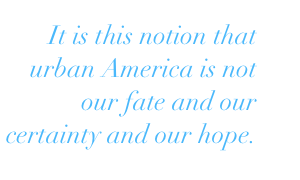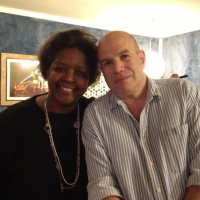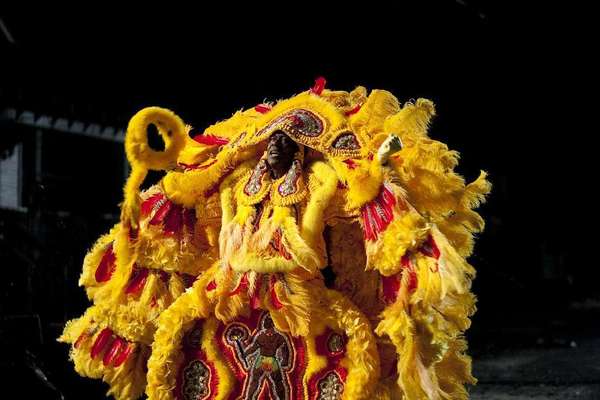
Treme’s David Simon
“I’m a storyteller.”

For most of his working life, David Simon has been telling an epic story of the American city — one corner at a time. First on the pages of The Baltimore Sun, then in the books Homicide: Life on the Killing Streets and The Corner: A Year in the Life of an Inner-City Neighborhood.
But it was on television that David Simon found his biggest and most devoted audience. NBC’s Homicide: Life on the Street and HBO’s The Corner and The Wire presented crime and punishment in an entirely new way. Detectives and criminals became extraordinarily ordinary people.
“When I was covering the police beat in Baltimore … it took years before I was able to understand that maybe the dope on the table wasn’t the story,” Simon told Gwen on this week’s show. “Maybe there was something else to pay attention to.”
At his hand, television became a place of brutal honesty and beauty.
David Simon has done something remarkable on TV: he’s confounded all the hype. His characters have been called Shakespearean. Harvard University has a sociology class devoted to understanding urban America based on Simon’s characters and storylines. Indeed, his work has been offered as a test of cultural literacy — all of which he eschews.
“I’m a storyteller,” he tells Gwen. “I’m still interested in the same things I was when I was a reporter. I’m interested in political arguments, social argument, economic argument. I’m interested in the argument.”
In Treme, which has just completed its run on HBO, Simon explored New Orleans’ viability as an expression of its culture. After the 2005 levee failure, keeping New Orleans cuisine and music alive was complicated and — at times — illegal. But the characters persevere. According to Simon, every American city could benefit from the New Orleans example of valuing commmunity and society.
So sit back for a conversation – and yes, argument — with David Simon.
Find out how you can support Music Inside Out
Connect with David Simon & HBO’S Treme
David Simon’s Website | HBO’s Treme | iTunes
The Place of Music In Storytelling
When David Simon sent the script for the first episode of Treme to HBO executives in Los Angeles, he says he included a playlist and the following advice:
“When you get to the part in the script where there’s some music in the pilot, listen to the music.”
The musical culture of New Orleans is central to the show — the songs AND the musicians.
“There’s something about New Orleans that you can’t explain to people who haven’t been here,” Simon says. “It’s the participatory nature of culture. A parade is not something you watch pass by, it’s something you get into.”
While much of the story was fictionalized, Treme benefited from featuring authentic musicians singing their own songs in their own city.
“It a little more real because they kicked in,” Simon told Gwen. “And that’s everybody from … people like Dr. John or Toussaint, down to the freshest, youngest brass band.
“We felt like we honored the stories we were trying to tell about actual people. They were not hyperbolic, they were not gangsters, they were not national politicians walking in the West Wing, they were not doctors in an Emergency Room — they were ordinary people, and to the extent they weren’t ordinary, they were culture-bearers, which is something that really doesn’t get a lot of currency in TV.”
Two Americas
In the fall of 2013, David Simon delivered the keynote address at the Festival of Dangerous Ideas (FODI) in Sydney. Presented by the Sydney Opera House, FODI 2013 focused on the proposition that some people are more equal than others.
Simon’s talk provided him an opportunity to synthesize ideas he has worked out on-screen in The Wire and Treme and online at his blog The Audacity of Despair.
Namely, that there are now two Americas.
America is a country that is now utterly divided when it comes to its society, its economy, its politics. There are definitely two Americas. I live in one, on one block in Baltimore that is part of the viable America, the America that is connected to its own economy, where there is a plausible future for the people born into it. About 20 blocks away is another America entirely. It’s astonishing how little we have to do with each other, and yet we are living in such proximity.
There’s no barbed wire around West Baltimore or around East Baltimore, around Pimlico, the areas in my city that have been utterly divorced from the American experience that I know. But there might as well be. We’ve somehow managed to march on to two separate futures and I think you’re seeing this more and more in the west. I don’t think it’s unique to America.
I think we’ve perfected a lot of the tragedy and we’re getting there faster than a lot of other places that may be a little more reasoned, but my dangerous idea kind of involves this fellow who got left by the wayside in the 20th century and seemed to be almost the butt end of the joke of the 20th century; a fellow named Karl Marx.
I’m not a Marxist in the sense that I don’t think Marxism has a very specific clinical answer to what ails us economically. I think Marx was a much better diagnostician than he was a clinician. He was good at figuring out what was wrong or what could be wrong with capitalism if it wasn’t attended to and much less credible when it comes to how you might solve that.
He goes on to discuss capital and capitalism and the metrics we use to measure our lives. Then, he talks about the effect he sees in communities.
And so in my country you’re seeing a horror show. You’re seeing a retrenchment in terms of family income, you’re seeing the abandonment of basic services, such as public education, functional public education. You’re seeing the underclass hunted through an alleged war on dangerous drugs that is in fact merely a war on the poor and has turned us into the most incarcerative state in the history of mankind, in terms of the sheer numbers of people we’ve put in American prisons and the percentage of Americans we put into prisons. No other country on the face of the Earth jails people at the number and rate that we are.
We have become something other than what we claim for the American dream and all because of our inability to basically share, to even contemplate a socialist impulse.
You can read an extended excerpt of Simon’s speech published in The Guardian.
The Value of Communities

Photo: Jason Rhein.
It’s always interesting to hear the language people use to talk about their work. When David Simon talks about creating television programs, he talks about “the currency” that ensures popular success: “violence, sex, and comedy.”
As a one-hour drama, Treme apparently wasn’t funny enough, sexy enough or violent enough to attract high ratings.
“I’m not going to complain about gangster stories when I did one effectively in Baltimore. We knew what we were up against selling this. Then further, we were going at the pace of real post-Katrina life, which means by standards of television drama we were going slow.”
It’s probably fair to say that Simon’s currency is “community.” That’s what he wants to see in a television drama. Simon is looking to understand how people establish and maintain a community in cities nationwide.
In essence the story we were trying to tell with Treme was something that we didn’t have room for in The Wire, which I think is sort of essential which is an argument for what the American city can achieve in terms of creating community and society.
By standards of real life these characters were actually going great journeys. The chef has three restaurants in four and a half years, but by standards of television it is a snail’s pace.
So, we think, if you look back on it, if somebody takes it off the shelf and watches these 35 hours at some point we think they will find something very close to approximating something that is novelistic, but it is not a genre novel, and they will find something very real and very compelling in the journey.
…
But they looked at it — and if I heard this once I heard it a thousand times — it was, “Well why don’t they leave? That town is screwed up.”
It is this notion that urban America is not our fate and our certainty and our hope… in the sense of we are not going back to rural people. Real American values are now city values and we are either going to live or die by how we function in these multi-cultural, increasingly compacted areas.
And it may be that the legacy of Treme will be to state in no uncertain terms for the historical record that New Orleans and the people of New Orleans have something to teach the rest of the country.
Once you get it in your blood that this is a way to live, it is hard to live in another way because it does offer these intense cultural forces that are affirming of community.
That is the power of the city. New Orleans delivers on the idea of community in a way that you can film it. I could with Treme say something that was implied with The Wire, but what was often overlooked, which was there is no choice. We either get this right, or we fail as a people.

Mardi Gras Indians
One of the real joys of watching Treme was witnessing the performances of any number of really fine actors, many of whom David Simon has worked with in the past. Among them: Clarke Peters, whose portrayal of Big Chief Albert Lambreaux was a masterwork.
He drew on the traditions of the Mardi Gras Indians.
“I think seeing an Indian at night on the street, organically, like St. Joseph’s night, there is nothing like it,” says David Simon. “To turn a corner and see — as if the world is muted in color — this apparition… to see it come between two shotgun houses and turn next to a rusting car and come towards you… this astonishing creature, this ridiculous beauty.”
Playlist
Each week we provide a playlist of the music heard on the broadcast. We hope you’ll add these songs to your music library and support the musicians who made them. Also don’t forget to visit local music retailers who help disseminate New Orleans music around the world.
The cover photo for this program was taken by Gregg Goldman.
